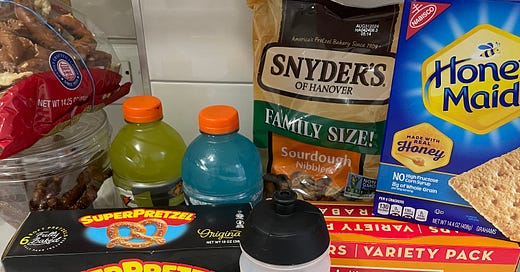If you’re new here, welcome to Run the Shoes, a newsletter about the simple pleasure of running. Subscribe to get emails like this in your inbox — it’s free!
Today’s newsletter is the second installment of my three-part Grandma’s Marathon series. (If you haven’t already, read the first one here.) The race is two days away and I am buggin’. There’s always so much planning in the final days before a marathon, especially if you’re traveling for it and bringing your baby. There are so many little things to remember for both of us: powders (sports drink for me, formula for her), sunscreen (the baby kind for her, the sport kind for me), bottles (one to mix my sports drink in, many for her), so many snacks for both of us. The list is long, but luckily it lives in both a Google doc and an iPhone note. It’s not easy being high-maintenance!
The weather on race day is looking… unpleasant. I’ve been monitoring it since last week and have become a bit of a savant in meteorology, if I do say so myself. Ten days ago, the weather forecast for Duluth was looking a little too hot and sunny for PRs. Now, it’s looking rainy with a chance of thunder, but much cooler in the mid 50s. I prefer cool and rainy to hot and sunny, but thunderstorms are cause for concern. The internet forums, which are never a great place to hang if you’re anxious about something, are floating around the idea of a cancellation due to lightning. Feels a bit alarmist! The good news is that there should be a nice tailwind to keep my butt moving fast. (Did you know that the direction of the wind in a forecast is the direction it’s coming from, not going? I did not!) It’s unclear if the rain is forecasted to be light or heavy but I’m preparing for the worst and bringing an old pair of never-used rain pants and a disposable poncho to wear before the race, when I’m just bopping from line to line for the port-a-potty.
The real meat of today’s newsletter is carb loading. Yesterday marked day one of a three-day carb load, where I’m attempting to consume around 500 grams of carbohydrates daily in the lead up to the race. That’s around 2,000 calories, a volume of pure carbohydrate intake that is past the point of being fun.
To take a step back, the point of carb loading is to essentially create a stockpile of glycogen in your muscles. Once consumed, carbohydrates combine with water to create glycogen, which is the most efficient form of energy for your body to use during exercise; it’s common wisdom that to run your fastest, you should load up your muscles with as much glycogen as they can store. For more on carb loading, I recommend this explainer from Featherstone Nutrition.
I probably consume close to 2,000 calories daily when I’m not carb loading, but the difference is that usually, a good amount of those calories come from protein and fat. When carb loading, you want to decrease the ratio of protein and fat while increasing carbs. That is precisely why it’s not as fun as it seems. Party carbs, like cookies and chips and pastries, have a lot of fat (mmm butter). Business carbs, however, are low on fat—pretzels, bagels, bread, bananas. Eating 500 grams of business carbs in a day is quite hard, which is saying a lot from someone who can easily down two bagels in a sitting. A good sized NYC bagel, for example, has 55-60 grams of carbs. So I need to consume the equivalent of nine of those a day.
If you’re thinking that you’d be too full to eat that many bagels, SAME! That’s why I’ve been consuming a fair amount of my carbs through sports drinks. The same reason why nutritionists say you shouldn’t drink sugary beverages normally is why you should drink them when carb loading. They’re high in carbs but don’t keep you full. I drink Gatorade, which is easy to find when traveling, and Maurten 160, a sports drink that tastes almost identical to the mix you have to drink before a glucose test when pregnant.
One final note on carb loading is that if you’re prone to self-hatred, you should absolutely not weigh yourself. Because glycogen is a combination of water and carbohydrates, your body holds onto extra water while carb loading. For what it’s worth, I think it’s best to avoid the scale for a week or so after a marathon too because your muscles are holding onto extra water as they repair themselves. AMA, I love to talk about water retention.
That’s all for today! Thanks for reading and see you on the other side!!






